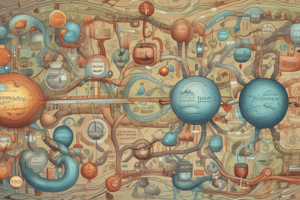Podcast
Questions and Answers
What is primarily affected in diabetes mellitus type I due to the absence of insulin?
What is primarily affected in diabetes mellitus type I due to the absence of insulin?
- Protein synthesis
- Glycogen breakdown
- Cholesterol levels
- Fatty acid metabolism (correct)
Which enzyme is deficient in hyperammonemia type I, leading to severe health complications?
Which enzyme is deficient in hyperammonemia type I, leading to severe health complications?
- Homogentisate 1,2-dioxygenase
- UDP-glucuronyl transferase
- Glucose-6-phosphate dehydrogenase
- Carbamoyl phosphate synthetase I (correct)
What is a common consequence of a deficiency of the glucose-6-phosphate dehydrogenase enzyme?
What is a common consequence of a deficiency of the glucose-6-phosphate dehydrogenase enzyme?
- Inhibition of fatty acid metabolism
- Accumulation of glycogen in the liver
- Increased cholesterol synthesis
- Oxidative stress leading to hemolysis (correct)
Which inherited condition results from the absence of UDP-glucuronyl transferase in liver cells?
Which inherited condition results from the absence of UDP-glucuronyl transferase in liver cells?
What metabolic disorder is characterized by the accumulation of glycogen due to a deficiency in glycogenolysis enzymes?
What metabolic disorder is characterized by the accumulation of glycogen due to a deficiency in glycogenolysis enzymes?
What process is responsible for the breakdown of macromolecules in cells?
What process is responsible for the breakdown of macromolecules in cells?
Which of the following characterizes an anabolic process?
Which of the following characterizes an anabolic process?
What is a potential consequence of a metabolic disorder?
What is a potential consequence of a metabolic disorder?
Which factor can cause metabolic disorders?
Which factor can cause metabolic disorders?
What is a characteristic of hyperlipoproteinemia type II?
What is a characteristic of hyperlipoproteinemia type II?
Which condition results from changes in the primary structure of proteins?
Which condition results from changes in the primary structure of proteins?
What role do hormones typically play in metabolism?
What role do hormones typically play in metabolism?
What may occur due to a deficiency of vitamin B complex?
What may occur due to a deficiency of vitamin B complex?
Flashcards
Alkaptonuria
Alkaptonuria
A metabolic disorder caused by a lack of the enzyme homogentisate 1,2-dioxygenase, leading to a build-up of homogentisic acid and its products in the body. This results in a dark urine and can lead to problems with joints and cartilage.
Glycogen Storage Disease
Glycogen Storage Disease
A group of inherited metabolic diseases where a deficiency of a key enzyme in glycogen metabolism leads to an accumulation of glycogen in the liver and other organs. This can cause a variety of symptoms depending on the specific enzyme that is deficient.
Lipidosis
Lipidosis
Inherited metabolic diseases where a deficiency of enzymes in the metabolism of lipids or phospholipids leads to an accumulation of lipids in various body tissues and organs.
Jaundice caused by inherited disease
Jaundice caused by inherited disease
Signup and view all the flashcards
Catabolism
Catabolism
Signup and view all the flashcards
Anabolism
Anabolism
Signup and view all the flashcards
Accumulation of Intermediates
Accumulation of Intermediates
Signup and view all the flashcards
Decrease or Absence of Final Product
Decrease or Absence of Final Product
Signup and view all the flashcards
Enzyme Deficiency
Enzyme Deficiency
Signup and view all the flashcards
Hormonal Deficiency
Hormonal Deficiency
Signup and view all the flashcards
Receptor Deficiency
Receptor Deficiency
Signup and view all the flashcards
Enzyme Inhibition
Enzyme Inhibition
Signup and view all the flashcards
Study Notes
Catabolism and Anabolism
- Catabolism: Breakdown of macromolecules into smaller intermediates.
- Carbohydrate catabolism: Glycolysis, HMP shunt, Krebs cycle, fructose and galactose metabolism.
- Protein catabolism: Proteolysis and amino acid breakdown.
- Lipid catabolism: Lipolysis, beta-oxidation, and ketogenesis.
- Anabolism: Synthesis of macromolecules from intermediates, requiring energy.
- Carbohydrate anabolism: Gluconeogenesis and glycogenesis.
- Protein anabolism: Protein and amino acid synthesis.
- Lipid anabolism: Lipogenesis, cholesterogenesis, and triglyceride/phospholipid synthesis.
Metabolic Disorders
-
Causes of metabolic disorders:
- Enzyme deficiencies (often genetic, rate-limiting enzymes). Examples include G6PD deficiency (anemia) and hyperlipoproteinemia type I.
- Hormone deficiencies. Examples include Diabetes Mellitus type I (genetic and non-genetic factors).
- Receptor deficiencies. Examples include Diabetes Mellitus type II.
- Enzyme inhibition (by ingested substances, e.g., carbon monoxide inhibiting cytochrome oxidase).
- Protein deficiencies. Examples include Wilson's disease (lack of ceruloplasmin for copper transport).
- Protein structure changes. Examples include sickle cell anemia (single amino acid change in hemoglobin).
- Interference between metabolic pathways. Example: protein synthesis problems affecting enzyme production.
- Substrate or coenzyme deficiencies. Examples include vitamin B deficiencies causing pellagra or beri-beri.
- Hormone imbalances. Example: increased thyroid hormone (hyperthyroidism) increasing metabolic rate.
-
Consequences of metabolic disorders:
- Intermediate accumulation (e.g., acidosis, hypercholesterolemia, hyperammonemia).
- Reduced/absent final products (e.g., abetalipoproteinemia, thalassemia, hemolytic anemia from G6PD deficiency).
- Increased alternative metabolic pathways (e.g., diabetes mellitus type I increasing fatty acid metabolism).
Examples of Metabolic Disorders
- Hyperlipoproteinemia type II: Genetic absence of LDL receptors leading to increased LDL/cholesterol in blood, potentially causing atherosclerosis.
- Diabetes mellitus type I: Insulin absence disrupts glucose metabolism, increasing fatty acid metabolism and potentially leading to ketoacidosis.
- G6PD deficiency anemia: Lack of G6PD enzyme results in RBC breakdown (hemolysis) due to oxidative stress.
- Hyperammonemia type I: Deficiency in carbamoyl phosphate synthetase I causing hyperammonemia.
- Jaundice (inherited disease): Absence of UDP-glucuronyl transferase in liver cells, leading to various jaundice syndromes (Crigler-Najjar, Gilbert).
- Lipidosis: Enzyme deficiencies in lipid/phospholipid metabolism leading to lipid accumulation (e.g., Hand-Schuller-Christian, Niemann-Pick, Tay-Sachs, Gaucher).
- Glycogen storage disease: Deficiency in glycogenolysis enzymes leading to glycogen accumulation.
- Alkaptonuria: Deficiency in homogentisate 1,2-dioxygenase affecting tyrosine metabolism.
Studying That Suits You
Use AI to generate personalized quizzes and flashcards to suit your learning preferences.




